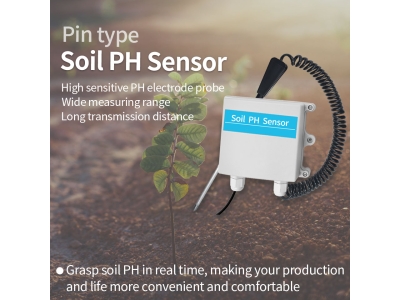The agriculture industry has undergone significant technological advancements in recent years, leading to improved efficiency and productivity. One of the key areas of innovation in this field is the development of advanced soil sensor systems, which have the potential to revolutionize the way farmers monitor and manage their crops.

Soil sensors are devices that are used to measure various parameters of soil, such as moisture levels, temperature, and nutrient content. These sensors provide real-time data that can be used to make informed decisions about irrigation, fertilization, and other aspects of crop management. In the past, farmers had to rely on manual methods of monitoring soil conditions, which were often time-consuming and imprecise. With the advent of advanced soil sensor systems, however, farmers can now access accurate and timely information about their soil, enabling them to optimize their farming practices and maximize crop yield.
There are several different types of soil sensors available on the market, each with its own unique capabilities and advantages. For example, some sensors are designed to be inserted directly into the soil, where they can measure parameters such as moisture content and temperature at various depths. Other sensors are installed above ground and use technologies such as electromagnetic induction or capacitance to measure soil moisture levels. Some sensors are even equipped with wireless connectivity, allowing farmers to access real-time data from their soil sensors remotely, using their smartphones or other devices.
One of the key benefits of advanced soil sensor systems is their ability to improve water management in agriculture. By providing accurate and timely information about soil moisture levels, these sensors enable farmers to apply irrigation more precisely, ensuring that crops receive the right amount of water at the right time. This not only conserves water but also prevents over-irrigation, which can lead to waterlogging and other detrimental effects on crop growth. In regions where water resources are scarce, such as arid or semi-arid areas, advanced soil sensor systems can be particularly valuable in helping farmers make the most efficient use of limited water supplies.
In addition to water management, soil sensors also play a crucial role in optimizing fertilization practices. By providing data on soil nutrient levels, these sensors enable farmers to apply fertilizers more precisely, ensuring that crops receive the nutrients they need for healthy growth. This not only improves the efficiency of fertilizer use but also reduces the risk of nutrient runoff, which can have negative environmental impacts. Furthermore, by monitoring soil conditions over time, soil sensors can help farmers identify trends and patterns in soil health, enabling them to take proactive measures to maintain the long-term fertility of their land.
Another important benefit of advanced soil sensor systems is their ability to support precision agriculture. Precision agriculture is an approach to farming that uses technology to tailor farming practices to the specific needs of individual fields or even individual plants. By providing detailed, site-specific data about soil conditions, soil sensors enable farmers to implement precision agriculture techniques such as variable rate irrigation and fertilization. This can lead to significant improvements in crop yield and quality, as well as cost savings and environmental benefits.
In recent years, the development of advanced soil sensor systems has been driven by advances in sensor technology, as well as by the growing demand for sustainable and efficient farming practices. As a result, there is now a wide range of soil sensor products available on the market, catering to the diverse needs of farmers around the world. These sensors vary in terms of their capabilities, accuracy, and ease of use, allowing farmers to choose the right solution for their specific requirements.
Despite the numerous benefits of advanced soil sensor systems, their widespread adoption in agriculture has been somewhat limited. One of the main barriers to adoption is the cost of these systems, which can be prohibitive for many farmers, especially those in developing countries or small-scale operations. Furthermore, there is a need for more research and education to help farmers understand the potential benefits of soil sensors and how to integrate them into their farming practices effectively.
To address these challenges, there is a growing need for collaboration between governments, research institutions, and private sector companies to develop affordable and user-friendly soil sensor solutions. This could involve initiatives to subsidize the cost of soil sensors for farmers, as well as efforts to provide training and support to help farmers make the most of these technologies. Furthermore, there is a need for continued research and development to improve the accuracy and reliability of soil sensors, as well as to explore new applications and capabilities for these systems.
In conclusion, advanced soil sensor systems have the potential to revolutionize agriculture by providing farmers with accurate and timely data about their soil, enabling them to optimize their farming practices and maximize crop yield. These systems have the potential to improve water management, fertilization practices, and support precision agriculture, leading to cost savings, environmental benefits, and improved food security. However, there are still challenges to be overcome in terms of cost, accessibility, and education. By working together, stakeholders in the agriculture industry can help to overcome these challenges and unlock the full potential of advanced soil sensor systems for the benefit of farmers and the environment.






